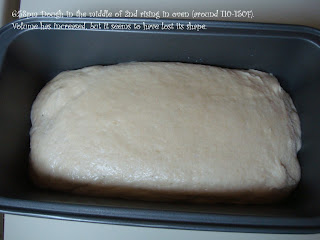Experimental Recipe: Parmesan cheese bread (make 1 loaf)
Ingredients:
Starter
- 1/2 cup warm water
- 1 teaspoon (tp) active dried yeast
- 1/2 cup all-purpose white flour
Dough
- 2 tablespoon (TB) honey
- 1 tp active dried yeast
- 2 TB and 1/2 tp unsalted butter
- 2.25 cup all-purpose white flour
- 1.5 tp salt
- 1/2 cup Parmesan cheese powder
- about 1/2 to 1 cup water
Procedure:
1. To prepare the starter: mix warm water, yeast and flour to form a liquid paste in a mug. Place in a warm water bath with cover to allow to rise to double the volume. It takes about 30 minutes.
2. To prepare the dough:
- mix flour, salt and cheese powder in a large bowl. Cut butter into very small pieces.
- Dissolve honey in equal amount of warm water, add yeast to the honey mixture.
- Once the starter has doubled its volume, add starter, dissolved honey, yeast and chopped butter into the large bowl. Mix with hands to incorporate with the flour mixture until everything is fully blended together to form a dough that cleans off the bowl.
- Knead dough vigorously for 30 minutes. Add water/flour accordingly, until dough is smooth and elastic.
3. First rising: Preheat oven to 150F and then turn heat off. Set dough in a greased pan. Cover with damp cheese cloth and set in warm oven for a few hours. Moist cheese cloth periodically.
4. Second rising: When dough has doubled and turned soft, take dough out of pan and knead again for 5 minutes. This time, dough should be very moist and spongy. But it is also cohesive, does not stick to the pan or the workplace. Grease the pan again if necessary. Replace dough in pan and cover with damp cheese cloth. Add a damp towel on top of pan without touching the cheese cloth to keep the moisture. Allow to rise again in oven until double.
5. Bake: After dough has doubled again, take the pan out of oven. Heat up oven to 450F. Put pan back into oven. Bake loaf at 400F for about 8 minutes. Turn heat down to 350F. Bake for another 15-20 minutes.
Result:
After the 1st kneading, dough appears to be in very good shape and texture:
This is the size of the dough with respect to the pan before the 1st rising:
After 4 hours in warmed oven, dough has risen with a good shape, but not doubled in volume:
Dough is then punched down and kneaded again for 5-10 minutes, then set in pan for 2nd rising:
During 2nd rising: after 1 hour and 30 minutes, dough has risen again, but it is getting out of shape:
After another 1 hour, dough has gotten so unbearably out of shape that I decided to bake it without delay:
After baking for 20-25 minutes, loaf is done, but its volume has not expanded significantly.
The taste of the bread is a little heavy. This is the texture of a slice at one end of the loaf, about 25 minutes after the loaf comes out of oven:
This shows the difference in texture between the end-part (middle) and the center-part (left) of the loaf. The crust is shown on the right side.
This shows the texture of different different parts of the loaf after slicing:
In summary, I have observed the following:
- The starter is prepared the same way as the Panera recipe. The yeast mixture almost doubles in 30 minutes.
- This time I use about 1/2 the amount of yeast in the dough, compared with the Panera's recipe for the same loaf. So the total amount of yeast used for the whole loaf is 2 tp instead of 3 tp. But I give more time for the dough to rise, and I allow it to rise twice.
- The first rising takes 4 hours. I preheat the oven to 150F. Then I turn the oven off and allow the dough to sit undisturbed throughout. The dough seems to do well in the 1st rising. It maintains its shape pretty well. But at the end of the 1st rising, it has not risen to the volume I'd like to see. I do not know if it's due to the age of my yeast (it's a few months old). But the fact that it still rises means it's alive.
- The second rising takes 2.5 hours. I reheat the oven to 150F and allow the dough to sit through, mostly undisturbed, with occasional peeking in. Apparently, if the dough is left to itself for too long, it gets flat. This happens during the 2nd rising. I am not sure if the oven temperature has contributed to the flatness. I should have knocked it down again and knead it before baking.
- The large holes in the loaf shows that the gluten in the loaf has indeed trapped the gas from the yeast. I am happy to see it. But I would like to see more of it at the center part of the loaf too.
Next experiment:
I'm going to try again with some new yeast. This time it will be a white bread.












No comments:
Post a Comment